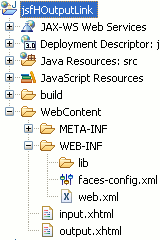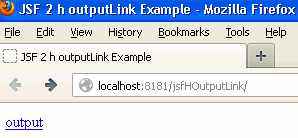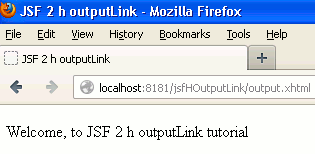In this tutorial you will learn about the JSF 2 h outputLink tag
JSF 2 h outputLink
In this tutorial you will learn about the JSF 2 h outputLink tag
<h:outputLink> tag of JSF 2 html tag library is rendered an HTML <a> (anchor) element. Body of this tag is rendered as the link text (anchor text). The 'value' attribute of this tag specifies the URL linked-to. This is as similar to the value what we were supplied to the HTML <a> 'href' attribute. So, with this tag the navigation rule can't be applied.
NOTE : If you will not use the value attribute the 'href' attribute in HTML code will assume the current page URL.
Attributes of JSF 2 h outputLink
- converter : This is not a required attribute. This
attribute is used when you are required to invoke a converter class in your
application when this link is clicked.
- id : This is not a required attribute. This attribute is
used to make the element uniquely identifiable. Value of this attribute must be
the unique within its closest parent component.
- rendered : This is not a required attribute. It evaluates a boolean expression. Presence of this attribute specifies that whether the
current component should be rendered in the Rendered Response phase or not or
worked on any later form submission. The default value of this attribute is
defined to true.
- value : This is not a required attribute. This attribute
specifies the page link. Value of this attribute is rendered as the value of
HTML 'href' attribute of <a> element.
- accesskey : This is not a required attribute. This attribute
evaluates the java.lang.String value, acted as an access key i.e used to create
a keyboard shortcut which can be accessed by the combination of
Alt+accesskeyValue or Alt+Shift+accesskeyValue (browser dependent combination) which transfers the
focus to the current element when it is pressed.
- charset : This is not a required attribute. This attribute is used to specify the character encoding of the resource.
- coords : This is not a required attribute. This attribute
is used to specify the position and shape for spotting the element on screen.
Generally used at the client side image maps
- dir : This is not a required attribute. This attribute
evaluates to the java.lang.String value that suggests the direction for the text
which doesn't inherit the property of maintaining a direction. The allowable
values are "LTR (Left-to-Right)" and "RTL (Right-to-Left)".
- disabled : This is not a required attribute. This attribute
evaluates to a boolean value which specifies whether this element will be get
focused or be admitted in the later form submission or not.
- hreflang : This is not a required attribute. This attribute is used to specify the resource's language code assigned by this hyperlink.
- lang : This is not a required attribute. This attribute is used to specify the language code for the component.
- onblur : This is not a required attribute. This attribute
evaluates to a java.lang.String value, specifies that when the focus of this
element is getting lost a Javascript code is executed.
- onclick : This is not a required attribute. This attribute
evaluates to a java.lang.String value, specifies that on
clicking of mouse pointer button over the current element a Javascript code will be executed.
- ondblclick : This is not a required attribute. This
attribute evaluates to a java.lang.String value, specifies that on the clicking
of mouse pointer button double over the current element a Javascript code will be executed.
- onfocus : This is not a required attribute. This attribute
evaluates to a java.lang.String value, specifies that when a current link gets the
focus a Javascript code will be executed.
- onkeydown : This is not a required attribute. This
attribute evaluates to a java.lang.String value, specifies that on a key pressed down
throughout the current element a JavaScript code is executed.
- onkeypress : This is not a required attribute. This
attribute evaluates to a java.lang.String value, specifies that when a key is pressed and
released throughout the current element a JavaScript code is executed.
- onkeyup : This is not a required attribute. This attribute
evaluates to a java.lang.String value. Code of Javascript is executed on
releasing of the key over the current element.
- onmousedown : This is not a required attribute. This
attribute evaluates to a java.lang.String value. Code of Javascript is run on pressing down
the mouse pointer.
- onmousemove : This is not a required attribute. This
attribute evaluates to a java.lang.String value. Code of Javascript is run on the pointer
button is moved inside the current element.
- onmouseout : This is not a required attribute. This
attribute evaluates to a java.lang.String value. Code of Javascript is run on the pointer
button is moved out from the current element.
- onmouseover : This is not a required attribute. This
attribute evaluates to a java.lang.String value. Code of Javascript is run on
the pointer button is moved onto the current element.
- onmouseup : This is not a required attribute. This
attribute evaluates to a java.lang.String value. Code of Javascript is run on
the pointer button is released over the current element.
- rel : This is not a required attribute. This attribute
describes the relationship of current document to the URL specified by this
hyperlink. It's values are of link types these link types are the
space-separated list of link types.
- rev : This is not a required attribute. This attribute
describes the reverse link from the specified URL by this hyperlink to the
current document. It's values are of link types these link types are the
space-separated list of link types.
- shape : This is not a required attribute. This attribute is
used to specifies the shape of this element to be positioned on the screen on
the client side image maps. Value of this attribute may be given as default (for
entire region), rect ( for the rectangular region), circle ( for the circular
region ), and poly ( for the polygonal region).
- style : This is not a required attribute. This attribute
evaluates to a java.lang.String value, which specifies that the CSS style will
be applied to this component when rendered.
- styleClass : This is not a required attribute. This
attribute evaluates to a java.lang.String value specifies the applicable CSS style
space-separated list to applied at the time of rendering. "class" attribute must
be used to pass this value.
- tabindex : This is not a required attribute. This attribute
is used to specify the tabbing order of this component in which Tab key pressed
it has to be selected. Value of this attribute must be an integer within the
range 0 - 32767. The component value 0 indicates the first component which is
selected in the Tab key press.
- target : This is not a required attribute. This attribute specifies the frame name where the resource is gotten through this hyperlink should be displayed.
- title : This is not a required attribute. This attribute
specifies the text information of the component as a tooltip when the mouse
pointer is hover over this link.
- type : This is not a required attribute. This attribute is
used to specify the MIME type (content type) of the resource assigned via this link. for example text/html, image/png, text/css etc.
- binding : This is not a required attribute. This attribute evaluates to a javax.faces.component.UIComponent specified for linking the component with the property of backing bean.
Example :
Here I am giving a simple example which will demonstrate you about the use of JSF 2 h outputLink tag in JSF applications. In this example I have created a JSF view page where I have used this tag with the value attribute into which passed the URL output.xhtml page where I want to go after click on the text.
Directory Structure

input.xhtml
<!DOCTYPE html PUBLIC "-//W3C//DTD XHTML 1.0 Transitional//EN" "http://www.w3.org/TR/xhtml1/DTD/xhtml1-transitional.dtd"> <html xmlns="http://www.w3.org/1999/xhtml" xmlns:h="http://java.sun.com/jsf/html" xmlns:f="http://java.sun.com/jsf/core"> <h:head> <title>JSF 2 h outputLink Example</title> </h:head> <h:body> <f:view> <h:form> <h:outputLink value="output.xhtml">output</h:outputLink> </h:form> </f:view> </h:body> </html>
output.xhtml
<!DOCTYPE html PUBLIC "-//W3C//DTD XHTML 1.0 Transitional//EN" "http://www.w3.org/TR/xhtml1/DTD/xhtml1-transitional.dtd"> <html xmlns="http://www.w3.org/1999/xhtml" xmlns:h="http://java.sun.com/jsf/html" xmlns:f="http://java.sun.com/jsf/core"> <h:head> <title>JSF 2 h outputLink</title> </h:head> <h:body> <f:view> <p>Welcome, to JSF 2 h outputLink tutorial</p> </f:view> </h:body> </html>
web.xml
<?xml version="1.0" encoding="UTF-8"?> <web-app xmlns:xsi="http://www.w3.org/2001/XMLSchema-instance" xmlns="http://java.sun.com/xml/ns/javaee" xmlns:web="http://java.sun.com/xml/ns/javaee/web-app_2_5.xsd" xsi:schemaLocation="http://java.sun.com/xml/ns/javaee http://java.sun.com/xml/ns/javaee/web-app_3_0.xsd" id="WebApp_ID" version="3.0"> <display-name>jsfHOutputLink</display-name> <welcome-file-list> <welcome-file>input.xhtml</welcome-file> </welcome-file-list> <servlet> <servlet-name>Faces Servlet</servlet-name> <servlet-class>javax.faces.webapp.FacesServlet</servlet-class> <load-on-startup>1</load-on-startup> </servlet> <servlet-mapping> <servlet-name>Faces Servlet</servlet-name> <url-pattern>/faces/*</url-pattern> <url-pattern>*.jsf</url-pattern> <url-pattern>*.xhtml</url-pattern> </servlet-mapping> <context-param> <description>State saving method: 'client' or 'server' (=default). See JSF Specification 2.5.2</description> <param-name>javax.faces.STATE_SAVING_METHOD</param-name> <param-value>client</param-value> </context-param> <context-param> <param-name>javax.servlet.jsp.jstl.fmt.localizationContext</param-name> <param-value>resources.application</param-value> </context-param> <listener> <listener-class>com.sun.faces.config.ConfigureListener</listener-class> </listener> <servlet-mapping> <servlet-name>Faces Servlet</servlet-name> <url-pattern>*.faces</url-pattern> </servlet-mapping> </web-app>
How To Run
After copying the above code paste them to the respective files or by downloading the code from Download Source Code start your web server and then use the following link http://localhost:8181/jsfHOutputLink//input.xhtml in the address bar of the web browser.
Output
When you will execute the above code the main page will be look like as follows :

In the above output page the text 'output' is the body link text specified in the body of the tag.
When you will click on the link then the output will be as follows :



[ 0 ] Comments